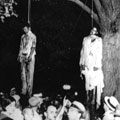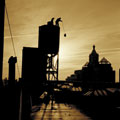Joe Richman: From PRX’s Radiotopia, this is Radio Diaries. I’m Joe Richman.
Robin London: Guys, if you ever need the restrooms, in Tompkins Square Park between the girls’ room and the boys’ room is a memorial dedicated to the victims of the Slocum disaster in 1904.
Joe Richman: That’s Robin London, a New York City tour guide, showing a group of tourists from Louisiana around the East Village. We’re in Tompkins Square Park right now, standing in front of a six-foot pillar. And etched into the marble are these words: Dedicated to the victims of the steamship, General Slocum.
Robin London: It says it right here on the side, and there’s a lion that’s pouring out water to remind you how they drowned. Close to 1100 people were killed that day. That was the worst disaster in New York history until 9/11. People don’t know about this memorial.
Joe Richman: It’s true. People don’t know about this memorial. And not just tourists from Louisiana. This is actually in my neighborhood. And for years, I walked through this park almost every day before I ever really noticed it, before I ever knew the story behind it.
On June 15th, 1904, the steamship called the General Slocum left the pier on East Third street, just after 9:00 AM. The boat was filled with more than 1300 residents of the Lower East Side. Many of the passengers were recent German immigrants who were headed up the East River for a church outing– a boat cruise and a picnic on Long Island. But they would never make it.
Back in 2004, I interviewed the last living survivor of the General Slocum. Today on the Radio Diaries podcast, we’re bringing you her story as part of our series, Last Witness.
Adella Wotherspoon: My name is Adella Wotherspoon. I was born November 28th, 1903. I’m a hundred years old. And I’m the last survivor of the General Slocum disaster.
Edward O’Donnell: I’m Edward T. O’Donnell. I’m a historian and the author of “Ship Ablaze: the Tragedy of the Steamboat General Slocum.” The General Slocum was an enormous boat, 300 feet long, four stories tall with these great big yellow smoke stacks right in the center of the ship and gleaming white paint on the hull, which had just been repainted.
Adella Wotherspoon: It was a supposedly a very good boat and a very handsome boat.
Edward O’Donnell: June 15th, 1904 was an exceptionally beautiful day. You’ve got people all along the railing of the ship, dressed in their very Sunday best, waving goodbye to people on the pier. And then as the wheels begin to turn, the boat begins to move forward, the band they’ve hired to come on board the ship begins to strike up and play.
The boat headed up the East River. At the astonishing clip of 15 knots, they began literally to see the city in front of them. The 14th street to 23rd street to 34th street to 42nd street to 59th street. Many of those people on board the boat had never been on a boat before.
Adella Wotherspoon: It was mostly women and children because it was on a work day. My father and my uncle took the time off. You have to remember I was only six months old. So what do you remember at six months?
Edward O’Donnell: 30 years after the fire in 1934, a Hollywood film, Manhattan Melodrama, which starred Clark Gable and William Powell, staged a quite stunning reenactment of the General Slocum disaster. It’s about 15 to 20 minutes into the journey up the East River, somewhere just off the tip of what’s now Roosevelt Island, that one of the mates was sitting at the bar having a mid-morning beer, when a young boy came up to him and said, “Mister, there’s smoke coming up the stairs.” And then seconds later, the flames began pouring up through the center of the ship.
Most of these people are parents and they’re rushing around trying to find their children, who they felt perfectly safe letting wander the ship. So these people had no idea where their children were and a sort of simultaneous recognition as the fire became evident among hundreds and hundreds of parents was, where are the children?
It spread faster than you could have possibly imagined. This boat was a floating Duraflame log. Within three minutes, the entire boat was on fire. And in 1904, very few people knew how to swim. And so these are people who have 10 seconds to make up their minds, whether they’d rather stay and most likely be burned to death or jump over the boat into the river.
And, you know, the water was almost as frightening as the fire. There were 2,500 lifepreservers on board the boat for 1300 passengers. So on the surface, that looked adequate. The problem was that the owner of the steamship, the Knickerbocker Steamship Company, had built the ship in 1891, outfitted it with life preservers and never replaced the life preservers.
Adella Wotherspoon: None of those were in good repair. And the stuffing, the cork stuffing, was all crumbled. They didn’t work.
Edward O’Donnell: What had once been solid chunks of cork had now become just fine dust. So people were putting them on around their necks, jumping overboard. As soon as these things hit the water, they absorbed water. And it was like having 25 pounds of dirt around your neck and pulled people right underwater.
Adella Wotherspoon: They put the children in the life preservers and threw them overboard and they sank. I guess they found many dead children with life preservers on.
Edward O’Donnell: Adella Wotherspoon does not know precisely how she was saved.
Adella Wotherspoon: I have no idea. I always thought, though my mother never said this, because she was so badly burned on her left side, I assume that she held onto the railing as long as she could before she dropped into the water. And I thought because her right arm seemed to be alright, that she’d helped me in her right arm. And whatever she was able to do in the water, she did. And she got me near enough to the shore, so they pulled us out.
Of my two sisters, Helen was never found and Anna was found with, still had her clothes on and so on. I had a feeling she was thrown in the water and drowned. Helen was six and Anna was three. And I was six months.
Edward O’Donnell: They knew a lot of people had died. They knew a couple hundred people had died as this was unfolding, but within about an hour or two after the fire, as they began to pull out the bodies out of the water, they just, at about 200 bodies, they, that was all they found. And so there was this moment in the middle of the afternoon where people said, maybe, you know, the talk of hundreds and hundreds of dying, maybe that was just an exaggeration.
But then when the tide turned in the middle of the afternoon, just shortly after that, um, submerged bodies began to appear and they were pulling them out, you know, several a minute. And it was clear from that point on that hundreds, maybe 500, maybe 600, by the next day, maybe a thousand had died.
Louisa Hartung: wife, age 47, occupation tailoress, killed in disaster. Francis Hartung: daughter, age 18, occupation piano teacher, killed in disaster. Elsie Hartung: daughter, age six, killed in disaster.
Adella Wotherspoon: There was no reason for the Slocum happening. The life preservers, had they been inspected and had the life rafts been put on the ceiling so that they could be brought down, you know, by people that wanted to use them, there was no need for the amount of destruction and the amount of loss of life.
Edward O’Donnell: In the end, only the captain was convicted and sent to jail. He was sent to jail for 10 years, served only three of those years before receiving a pardon. The directors and officers of the Knickerbocker Steamboat Company that owned the General Slocum, and was clearly responsible for those rotten life jackets and rotten fire hoses, [00:09:00] none of them were brought to trial, charges were all subsequently dropped. So they walked completely free, washed their hands of it. In fact, they dissolved the Knickerbocker Steamboat Company and ended up paying no damages to anybody because the corporation ceased to exist.
Adella Wotherspoon: After the Slocum, so many of the children had died that the place was so quiet, that 13th street area, that most of the families moved uptown. Each one of those apartments or houses or whatever they had in those days held so many memories for them, they just couldn’t stand it. My mother, she never talked about it and I’d never asked her. I think I was just very lucky that I got out of it in one piece. To have lived a hundred years doesn’t seem like a long time to me. In 1904, I was the youngest survivor of the General Slocum. And now at a hundred, I am the oldest survivor of the General Slocum.
Joe Richman: That was Adella Wotherspoon. She died a few months after I interviewed her back in 2004, at the age of 100. Thanks to historian Edward T. O’Donnell who wrote the book, “Ship Ablaze.” To see photographs of the General Slocum, go to our website, radiodiaries.org. Radio Diaries is produced by Nellie Gilles, Alissa Escarce, Mycah Hazel, and me. Our editors are Deborah George and Ben Shapiro. Our Marketing Operations Manager is Stephanie Rodriguez. Radio Diaries is part of Radiotopia, a listener-supported network from PRX. And we have support from the National Endowment for the Humanities, the NEA, NYSCA, and from listeners like you. I’m Joe Richman. Thanks for listening.








